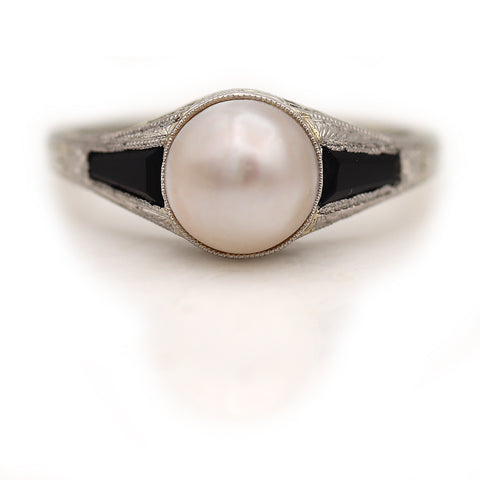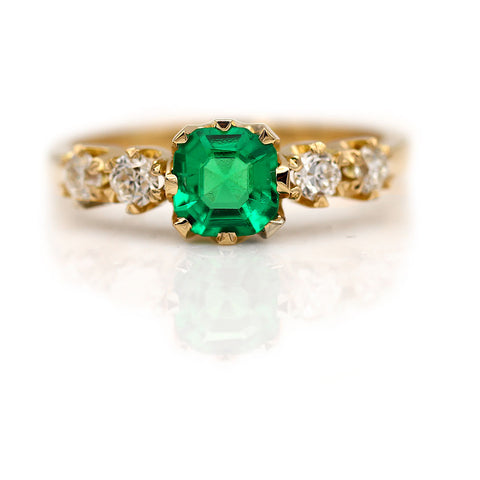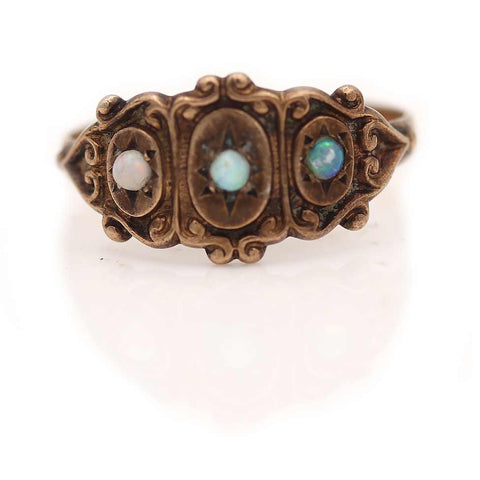Definitive Guide to Birthstones - Why Birthstones Matter?
May 02, 2024
by Suzanne Sachs • 5 min read

THE BASICS --
Birthstones are amazing gems, but why do they matter so much? Understanding the significance of birthstones can help you enjoy all the symbolism of these outstanding jewels, creating layers of individual meaning to make your jewelry even more special.
WHAT YOU NEED TO KNOW--
In this guide, we will explain the following:
- Origins of Birthstones
- Today's Birthstones
- January Birthstone
- Garnet
- Onyx
- February Birthstone
- Amethyst
- March Birthstone
- Aquamarine
- Bloodstone
- April Birthstone
- Diamond
- May Birthstone
- Emerald
- June Birthstone
- Pearl
- Moonstone
- Alexandrite
- July Birthstone
- Ruby
- August Birthstone
- Peridot
- Spinel
- September Birthstone
- Sapphire
- October Birthstone
- Opal
- Tourmaline
- November Birthstone
- Citrine
- Topaz
- December Birthstone
- Turquoise
- Blue Zircon
- Choosing a Non-Diamond Engagement Ring
Origins of Birthstones
The origins of birthstones are rooted in legends, traditions, and history, with different influences from a variety of different cultures. While there is no one singular source for the beginnings of monthly birthstone associations, there are biblical references to 12 gems on the breastplate worn by the Israelite high priest Aaron, representing the 12 tribes of Israel. Eventually, this evolved into wearing particular gems at particular times to invoke protective powers or other properties.
Christian tradition, on the other hand, associated certain gems with the 12 apostles of Jesus Christ, with the tradition of wearing one gem each month in honor of those sacred figures. Hindu traditions link particular jewels to celestial forces associated with astrological birth charts, and many other special gems have similar connections to different seasons or zodiac signs, making them preferred during certain months.
Today's Birthstones
The first modern list of birthstones associated with specific calendar months was delineated in 1912 by the National Association of Jewelers, which chose different gemstones based on not only their beauty and appeal, but also on marketability and the projected ability to sell the stones to a broad audience. That list has been amended several times, most notably in 1952, 2002, and 2016, when new gems have come into fashion.
Today, there are several different birthstones associated with each month. Some lists reference guardian angels, zodiac symbols, or other significance. Regardless of the choice, multiple birthstones gives everyone great variety to choose the birthstone they prefer.
The most commonly accepted birthstones by month are:
January Birthstone
• Garnet
Garnet is a silicate mineral that comes in a variety of colors, though it is most commonly known for its deep red hue. Garnets also come in a variety of colors including blue, green, purple, yellow and orange.
• Onyx
Onyx is a cryptocrystalline quartz, which means it has a fine and uniform crystal structure that is not easily visible to the naked eye. It typically forms in parallel bands, often in shades of black and white, but it can also occur in other colors such as brown, red, green, and blue.
February Birthstone
• Amethyst
Amethyst is a variety of quartz that is prized for its beautiful purple color. It ranges in color from pale lilac to deep purple and is often associated with qualities such as tranquility, balance, and clarity. The purple coloration of amethyst is due to trace amounts of iron within the crystal lattice, which can be affected by factors such as heat and radiation exposure.
“I've purchased two vintage rings from Suzanne over the past decade and my wife has loved both. Great service, communication and speedy delivery.”
March Birthstone
• Aquamarine
Aquamarine is a variety of the mineral beryl, which is a type of silicate mineral that also includes emerald. Aquamarine is known for its delicate blue to blue-green color, reminiscent of the clear waters of the sea.
• Bloodstone
Bloodstone, is a dark green variety of chalcedony with red or brown spots or streaks resembling drops of blood, giving it its distinctive name. The red spots are caused by the presence of iron oxide impurities.
April Birthstone
• Diamond
Diamond is a form of carbon, known for its exceptional hardness and brilliance, making it one of the most prized gemstones in the world. Diamonds are typically clear or colorless, but they can also occur in various colors such as yellow, brown, blue, pink, and green.
May Birthstone
• Emerald
Emerald is a gemstone and a variety of the mineral beryl, colored green by trace amounts of chromium and sometimes vanadium. It's known for its rich, vibrant green color, which can range from light to dark shades.
June Birthstone
• Pearl
A pearl is a unique gemstone produced within the soft tissue of a living shelled mollusk, such as an oyster or mussel. It's formed when an irritant, such as a grain of sand or a parasite, enters the mollusk's shell and becomes coated with layers of nacre, a crystalline substance that the mollusk secretes. Over time, these layers build up and create the smooth, lustrous surface characteristic of pearls.
• Moonstone
Moonstone is a captivating gemstone known for its distinctive shimmering appearance, which resembles the soft glow of moonlight reflecting off water. It belongs to the feldspar mineral group. The most common color of moonstone is a milky white or colorless, but it can also occur in shades of peach, gray, and blue.
• Alexandrite
Alexandrite is a remarkable and rare gemstone known for its fascinating color-changing properties. It belongs to the chrysoberyl mineral group and is named after the Russian tsar Alexander II.
July Birthstone
• Ruby
Ruby is a precious gemstone known for its vibrant red color and exceptional hardness, second only to diamond. It is a variety of the mineral corundum, which is composed of aluminum oxide. The rich red color of ruby is due to the presence of chromium within the crystal lattice.
August Birthstone
• Peridot
Peridot is a beautiful gemstone with a distinctive olive-green to yellowish-green color. It is the gem-quality variety of the mineral olivine, which is a magnesium iron silicate. Peridot's green color comes from the presence of iron within its crystal structure.
• Spinel
Spinel is a gemstone that comes in a variety of colors, with red and blue being the most famous. It's often mistaken for ruby or sapphire due to its resemblance to these gemstones, but spinel has its own distinct characteristics and properties.
September Birthstone
• Sapphire
Sapphire is a precious gemstone known for its stunning blue color, though it can occur in various other colors as well, such as pink, yellow, green, purple, and orange. Sapphires that exhibit a deep, intense blue hue are particularly prized and are often referred to as "cornflower blue."
October Birthstone
• Opal
Opal is a mesmerizing gemstone known for its vibrant play-of-color, which is a phenomenon where the stone displays a spectrum of colors that seem to dance and shimmer as it's moved under light. This play-of-color is caused by the diffraction of light by silica spheres within the microstructure of the opal.
• Tourmaline
Tourmaline, a boron silicate mineral, is a colorful gemstone that occurs in a wide variety of hues, ranging from vivid greens and blues to pinks, reds, yellows, and even colorless varieties.
November Birthstone
• Citrine
Citrine is a variety of quartz that is known for its warm, golden-yellow color, which can range from pale yellow to deep amber. This gemstone gets its name from the French word "citron," meaning lemon, due to its citrus-like hues.
• Topaz
Topaz, a silicate mineral, is a beautiful gemstone known for its striking colors and brilliance. It is typically transparent to translucent. Topaz comes in a variety of colors, including blue, yellow, pink, purple, and colorless.
December Birthstone
• Turquoise
Turquoise is a captivating gemstone known for its unique blue to greenish-blue color, reminiscent of the vibrant hues of the sky and sea. It is a hydrated phosphate mineral composed of copper and aluminum, often with traces of iron. Turquoise is prized for its striking color, which can range from sky blue to greenish-blue, with veins or patches of matrix, or host rock, running through it.
• Blue Zircon
Blue zircon is a gemstone prized for its intense blue color and exceptional brilliance. It is a naturally occurring mineral belonging to the group of silicate minerals called zirconium silicates.
Why Birthstones are Important?
Birthstones provide a symbolic, largely recognized connection to an event or specific month, giving us a way to commemorate and personalize jewelry with rich, meaningful notations. While the most common use of birthstones is exactly as they are named – to recognize a birthday, either for yourself, a spouse or partner, a child, grandchild, or special friend or relative – there are many other options for how to use birthstones in rings, earrings, and other jewelry.
• Anniversaries
A birthstone can easily symbolize the month of an important anniversary, such as for a wedding, a first date, a first kiss, or a proposal.
“Suzanne was amazing! I utilized the layaway service and it was a breeze. Ring made its way to Texas and was even more gorgeous in person."
— Chloe G verified buyer
• Significant Events
Mark a significant event such as a graduation or adoption with a special piece of birthstone jewelry. Giving birthstone jewelry to commemorate the birth of a child, such as a birthstone ring or pendant, is a meaningful way to mark the occasion.
• Promise
Birthstones are popular choices for promise rings, whether for a romantic
promise or a vow of another kind, such as chastity or sobriety.
• Accomplishments
A birthstone can celebrate a monumental accomplishment, such as meeting a weight loss goal, earning a promotion, or some other life goal step.
• Memorials
Commemorating someone special, whether a friend, relative, or even a
pet, can be done with a birthstone.
“My experience with Vintage Diamond Ring was so excellent I really had to think about it for a while. First their selection of jewelry is profound. The quality is superior.”
— Claude P verified buyer
• Engagement
Using a birthstone ring as an engagement ring can be a unique and meaningful choice, adding a personal touch to the ring and symbolizing the individuality and special bond between the couple.
Choosing a Birthstone Ring
Ultimately, you can choose to use birthstones in any way you wish, with whatever symbolism means the most to you. With a range of gems to choose for each month, you can always find a gorgeous stone to represent whatever you want to commemorate for each month.
Suzanne Sachs
Suzanne has always believed vintage rings can change lives. She's been in the jewelry industry for over 35 years, working with vintage jewelers, diamond dealers, diamond cutters, and gemologists. Suzanne started Artdecodiamonds in 2000 and understood the demand for vintage rings throughout the world. She ultimately started VintageDiamondRing.com in 2014, and understands each vintage ring is a reflection of you – your history, your relationships, your style, your elegance and is honored to have the opportunity to help you showcase your flair in a unique and exquisite way.































